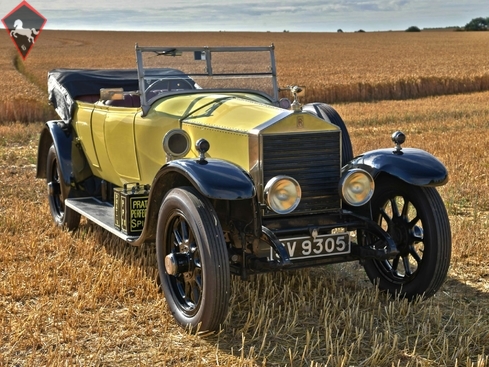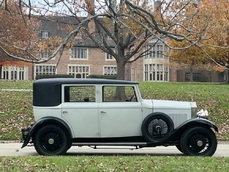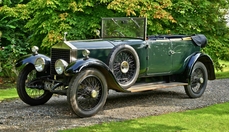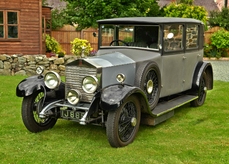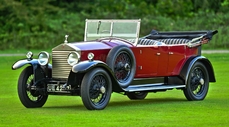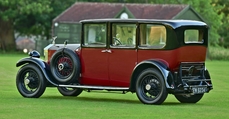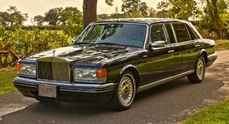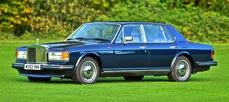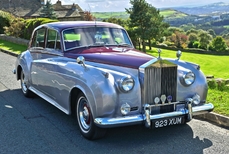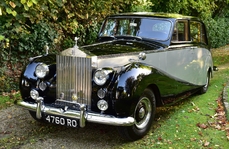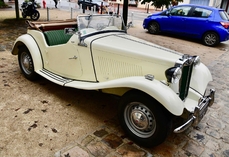Rolls-Royce 20 hp Tourer by Hastings of Melbourne 1923
General description :
1923 ROLLS-ROYCE 20hp four door tourer
Chassis No 67H2
Original Works No 290
Engine No G327
Registration No SV9305
Colour: Primrose over Black.
Under several decaldes long ownership; this is a particularly pretty & correct car in super driving order. The owner of this car has gone to extraordinary lengths to ensure the car is complete with tools & spares down to the last detail. Even the Pratts Motor spirit can isof the correct type & year for the car.
This very early 20hp with three speed centre change gearbox has a number of rare, early features and a complete toolkit.
The solid nickel radiator has the rounded edges of early production cars rarely seen now. The radiator shutters are black painted, as original. The 23 inch, detachable rim wheels are of the artillery type. The spare wheel is side mounted but can be rear mounted as the (often missing) rear mounting brackets are complete. The rear luggage carrier mounts a large Brooks motoring trunk with two fitted suitcases
The ignition coil is of the Rolls-Royce, square based, bakelite type mounted on top of the rocker box. The engine bay features a complete set of undertrays. All bolts are the correct square head type. No magneto was fitted to this chassis; the build records confirm this.
The Spirit of Ecstasy radiator mascot is believed to be an original. There is also a town cap.
The dashboard has all the correct matching and working instruments, controls, switches and lamps. (The headlamp dimmer is not wired in) The windscreen wiper is a Lucas, nickel finish, vacuum type in good, working order. The tank mounted petrol gauge is present and works but is in need of calibration.
All the leather gaiters on the springs, steering and suspension joints are in excellent condition.
The front floorboards are the originals and bear the works number (290) as well as the chassis number (67H2). The works number, 290, is also stamped onto the chassis extension on the nearside at the rear and the offside at the front. The original heel board is fitted.
The battery box is an original, complete with lid and all original fittings.
Flashing indicators are neatly concealed in the original CAV, wing mounted sidelamps at the front and fitted to divers helmet lamps at the rear, matching the rear tail/brake lamps.
The switch and warning light are appropriate dashboard fittings and in no way incongruous.
The Klaxon horn works well as does the large Boa Constrictor horn.
The headlamps are of the fixed dip type and, fitted with LED bulbs, use little current. They are nickel plated and have that lovely dull patina.
The bonnet locks are in working order as is the ignition key lock, the tool tray locks and the trunk locks
The car has a really nicely constructed, totally appropriate body built by Hastings of Melbourne, replicating the Barker barrel-sided design of the 1920s, including correct detail such as the double curvature doors with beaded edges, attractive, horizontally and vertically divided windscreen with suitable rear view mirrors, all well proportioned and authentic looking. This replaces the second saloon body, fitted in 1934, which itself replaced the original Smith and Waddington saloon. The tan leather upholstery is in excellent condition with no holes or tears. The door cards are in very good condition, each with a storage pocket. The paintwork is in generally good condition appropriate to its age (probably about 40 years) There are no dents, dings or corrosion to the bodywork. The brightwork has a lovely patina.
The car comes with a full, nicely made set of wet weather gear, including side screens, correct set of lamps and various other characterful touches. There is a rear (Auster type) screen and apron. There is a cabinet in the rear of the front seat which can contain the side screens and side curtains. On the cabinet door is mounted a bezel wind clock. The engine is running sweetly and the car drives well. The large hood allows for plenty of space inside.
Under the current ownership the car has had all original wiring replaced.
TOOLS & SPARES
These merit a separate and full description as a set so complete is unlikely to be seen anywhere else.
The tools and spares are carried:
In two drawers under the nearside running board.
In a box mounted on the nearside running board.
Under the front seat.
The Lucas 140 oiler is mounted in the engine bay on the nearside undertray.
Two, two gallon Pratts petrol cans are mounted on the offside running board. One is of 1923, the other of 1936.
The box on the nearside running board contains: The Michelin 1,000kg “Flirt” jack with hinged T handle; the petrol funnel; the Liqal petrol filler with detachable, flexible connector F10552; the Dunlop wheel spanner (restored); the wooden mallet; the Dunlop rim removal tool.
Under the front seat are: spare cylinder head gasket x 2; the crank handle; the Hydrometer; the half round file; the hammer; the chisel; the valve spring clamp; the Dunlop “Mortier” foot pump with connector and a wooden box with assorted washers, nuts, bolts and so on. A Lucas spare bulb holder with mounting bracket. A nickel plated inspection light with mounting bracket. The Enots oil gun.
The drawers under the nearside running board hold some exceptionally rare items: Box for electrical spares, D50842, with full, original, unused contents; Box for distributor tools with correct contents; six KLG spark plug tin boxes in as new condition each containing an 18mm spark plug, paper wrapped with an unbroken seal.
The drawers also contain a full complement of original jaw spanners, box spanners and tommy bars, C spanners, screwdrivers, pliers; plus feeler gauges, Lucas adjustable spanner, valve grinding tool, Schrader tyre gauge and all the other small tools listed in the parts book.
There is a further storage space under the rear seat which holds modern items, jack, wheel spanner etc.
Also mounted on the nearside running board is a brass fire extinguisher on an original bracket.
The car comes complete with a near mint original handbook (December 1922). A copy of the Catalogue of parts (February 1924) and copies of the original build cards.
This chassis came off test in May 1923 and was shipped to Australia where it was fitted with a saloon body by Smith and Waddington and sold to a Mr Winterbottom then John Wyatt, a Sydney bookmaker. On May 30th 1928 an engine replacement was carried out under warranty at the works. In 1934 a six light saloon body by Martin and King was fitted. Several other subsequent owners are listed in “Rolls-Royce and Bentley in the Sunburnt Country” Owner Dr Paul Crea of Northbridge, New South Wales had the tourer body fitted. The car was imported into the UK in 2002 by The Real Car Company who sold it to the current vendor. At that time the DVLA allocated the age related registration number, SV9305. It has been in constant, but modest, use ever since. It runs smoothly with good oil pressure and without over heating. Having a relatively light body, the rear only brakes are adequate but do require an appropriate driving style.
Call Richard Biddulph.
Mobile ++44 (0) 7967 260673
Sales & ValuationsVintage & Prestige of Northampton Ltd.richard@vandp.netwww.vandp.netShowroom:2 Ryehill Ct, Lodge Farm Industrial Estate, Northampton NN5 7UA
Service & Trim:Unit 29, Globe Industrial Estate. Grays Essex, RM176STViewings & Visits Strictly by appointment only please. We have on site long term storage for over 200 cars with 24 hour security & covered trailer delivery to customers anywhere in Europe.
1923 Rolls-Royce 20 hp Tourer by Hastings of Melbourne is listed for sale on ClassicDigest in Essex by Prestige House for Not priced.
Car Facts
Car type : Car Make : Rolls-Royce Model : 20 hp Model Version : Tourer by Hastings of Melbourne Engine size : 0.0 Model Year : 1923 Sub type : Station wagon Location : Essex Vehicle Registration : Undefined
Not priced
Seller Information
Vintage & Prestige
Prestige House
+44(0)1375 379719, +44(0)7967 260673
Prestige House
+44(0)1375 379719, +44(0)7967 260673
People who viewed this Rolls-Royce 20 hp also viewed similar Rolls-Royce listed at ClassicDigest
Other cars listed for sale by this dealer
About Rolls-Royce
Well, ladies and gentlemen, today we're diving into the illustrious history of a brand that has always embodied the very essence of British luxury and craftsmanship - Rolls-Royce.Our story begins at the turn of the 20th century when two visionaries, Charles Rolls and Henry Royce, decided to join forces. In 1904, the very first Rolls-Royce was born, the Rolls-Royce 10 hp. It was a modest start for a company that would go on to redefine automotive excellence.
But it wasn't until 1907 that Rolls-Royce truly made its mark with the introduction of the Silver Ghost. It was hailed as the "Best Car in the World" and set the gold standard for luxury motoring. With its whisper-quiet engine and exquisite craftsmanship, it was a statement of opulence and refinement.
The 1920s brought us the Rolls-Royce Phantom I, an icon of its time. It was the first Rolls-Royce to feature a 6-cylinder engine and set the stage for the legendary Phantom line. This was the era when the Maharajas of India commissioned custom-bodied Rolls-Royces that were nothing short of automotive palaces.
Fast forward to the post-war years, and we have the Silver Cloud, a symbol of post-war British optimism. The Silver Cloud was elegance personified, with its flowing lines and handcrafted interiors. It was the choice of royalty, celebrities, and captains of industry.
But if we're talking about the epitome of Rolls-Royce luxury, it's the Rolls-Royce Phantom VI, which graced us with its presence from 1968 to 1991. This was a car that made the statement that "if you have to ask the price, you can't afford it." Customization was the name of the game, and the Phantom VI was a canvas for the world's wealthiest to express their unique tastes.
Now, it's impossible to discuss Rolls-Royce without mentioning the Rolls-Royce Corniche. Produced from 1971 to 1995, it was a convertible and coupe version of the Silver Shadow. The Corniche was the quintessential grand tourer, a car for those who wished to traverse continents in absolute luxury.
But, alas, even the mightiest must face their decline, and Rolls-Royce was no exception. The company went through financial turmoil in the 1970s and 80s, leading to the takeover by Vickers plc. Then came the controversial BMW and Volkswagen ownership period, which divided enthusiasts.
Rolls-Royce regained its footing under BMW ownership, and the new millennium brought us the Rolls-Royce Phantom VII, a return to the company's roots of uncompromising luxury. The Phantom VII was a testament to British engineering and craftsmanship.
And that, ladies and gentlemen, brings us to today. Rolls-Royce continues to produce some of the most opulent, bespoke vehicles on the planet, a symbol of British imperiousness that has not waned with time. The spirit of Sir Henry Royce and Charles Rolls lives on in every car that bears the Spirit of Ecstasy, a testament to the enduring legacy of British automotive excellence.
